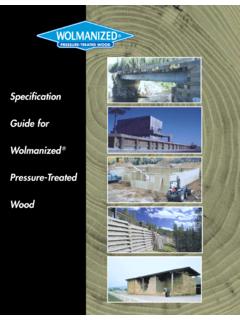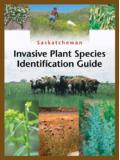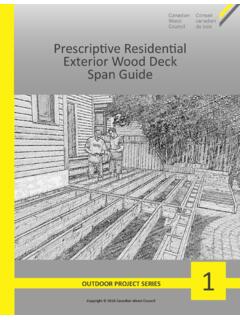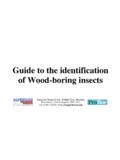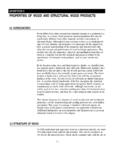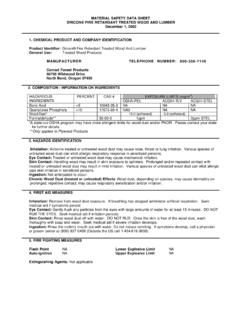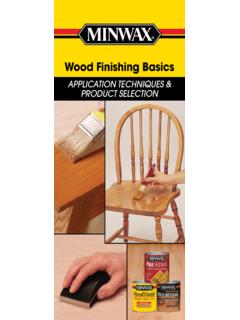Transcription of Specification Guide for Wolmanized Wood
1 Specification Guide for Wolmanized Pressure-Treated Wood2 Wolmanized wood is poles, piles, timbers, posts, or plywoodthat is pressure-treatedwith CCA preservative to providestructural protection from termites and fungal decay. For 70years, CCA-treated wood has been specified in a wide varietyof applications; as of December 30, 2003, Wolmanized woodmay be produced for only the uses shown in the next used as recommended, CCA-treated wood is harmless topeople,plants, and animals. Its use provides environmentalbenefits as well as decades of Wolmanized wood and plywood for applications in which conditions conducive to termites and fungal decay are present. Thisincludes wood that will be in contact with water, soil, concrete or masonry, subject to periodic wetting, or exposed to moisture or high humidity. Wolmanized wood is suitable for a wide variety of applications, including: Lumber for Salt Water Use Piling Poles Plywood Highway Construction Poles, Piles and Posts Used as Structural Members on Farms Agricultural fence posts (round, half-round, quarter-round)For residential and other applications requiring a next-generation preservative, specify Wolmanized Natural Select wood ( ).
2 Wolmanized Pressure-Treated WoodWhen to Specify Marine Construction Permanent Wood Foundations Building Poles and Posts Sawn Structural Timbers Sawn Crossarms Structural Glued Laminated Members Structural Composite Lumber Shakes and Shingles Cooling TowersContentsWhat is CCA & How Does It Work?..Retention, Penetration, Use Category System ..Recommended Hardware, Species, Design Values, Marine & Handling, The Treating chemical used to preserve Wolmanized pressure-treated wood is a mixture of oxides of copper, chromium, and arsenic and known as CCA. The preservative has been formulatedto render wood useless as a food substance for termites and fungi while keeping the woodattractive, clean, odorless, non-staining, and safe to handle when used as the commercially produced trivalentarsenic, the arsenic in Wolman CCA is in theform of inorganic pentavalent arsenate a naturally occurring trace element.
3 In the treatment process, described on Page 6, the pentavalent arsenate becomes fixed, or chemically bound, in the wood cells as highly leach-resistant insoluble reaction of chromated copper arsenate with the woodsubstrate is termed fixation because the preservative compounds are fixed in the treated wood in a highly insoluble state. However, some chemical may migrate from treated wood into surrounding soil over time and may also be dislodged from the wood surface upon con-tact with the skin. Fixation accounts for the permanency of the preservative in the treated wood, which explains the leach resistance and durability of the fixation mechanism is complex and the reactions involved are primarily dependent upon wood species,preservative formulation, concentration, and result, however, is that the preservative becomes leach-resistant is CCA and How Does It Work?
4 Chemical Composition of CCA-CAll Wolmanized wood is treated with CCA-Type C, which iscomposed of the Chromium (CrO3)Copper (CuO)Arsenic (As2O5)More on Fixation ..The effectiveness of preservatives at various retentions in differentspecies is evaluated using test stakes. Arch monitors some 50,000stakes in plots worldwide. Protection against rot, fungal decay, and termites 70 year successful track record Easy to work with, repair, and modify with common tools Strong, resilient, versatile, and economical Backed by Arch Wood Protection, the world s leader in wood preservation technologyFeatures & AdvantagesAWPA Retention Requirements1 Above groundGround / Fresh Water ContactSalt Water SplashPermanent Wood FoundationSalt Water ImmersionApplicationUse CategoryCCA (pcf)1, 2, 3A, , TIMBERS, AND PLYWOODS tructural PolesFoundation / Fresh WaterSalt Water AND PILESW olmanized pressure-treated wood is treated to various retention levels that are intended to protect the wood for particular applications.
5 Retention levels indicate the amount of preservative retained in the wood in a specific assay zone. In North America,retention is expressed in pounds per cubic foot (pcf).Retention levels or treating quality procedures are marked on Wolmanized wood. The accompanying table outlines CCA retention levels required by the American Wood-Preservers Association for various varies with depth in the wood, so preservative penetration also affects wood longevity. In species with large amounts of sapwood, such as southern and red pine, the preservative must penetrate inches or 85% of the sapwood to meet standards. In western species that are predominantly heartwood, the wood is incised to ensure a treated shell, and any cut surfaces should be field-treated in accordance with AWPA standard M4 with a preservative containing at least 2% and Penetration1 Wolman CCA preservative meets or exceeds AWPA P5 and Federal Standard TT-W-550.
6 The treating process andthe results above meet or exceed Federal Specification TT-W-571 and AWPA Commodity Standards as round piling used in the northern zone (New Jersey and north on the East coast, north of San Francisco Bay onthe West coast), a retention of pcf is acceptable (UC5A).AWPA Use Category SystemThe American Wood-Preservers Association,which establishes the standards for preserva-tives and treated wood,is introducing a new UseCategory system, basedon the service conditionsfor wood rather than onwood commodities. It isdesigned to reduce con-fusion among specifiersand consumers. Most building codes referenceAWPA standards, so the Use Category system will replace the Commodity standards in codes. Atright is a summary ofAWPA Use in yellow areongoing uses for CCA-treated , not in contact with ground or foundationInterior, subject to dampnessExterior, above ground, coatedExterior, above ground, may be finishedExterior, ground or freshwater contact in areas with low riskExterior, ground or freshwater contact, severe environments,high potential for deteriorationExterior, ground or freshwater contact, very severe conditions or very critical structural componentsSaltwater exposure north of San Francisco and New JerseySaltwater exposure south of San Francisco on West coast,New Jersey through Georgia on East coastSaltwater exposure south of Georgia, Gulf CoastFire protection, weather-shieldedFire protection, exteriorInterior furniture, millworkInterior beams, flooring, sill platePlywood sidingHighway bridge railingFence posts, deck posts, polesUtility poles.
7 Building poles, Permanent WoodFoundationsFreshwater piling, foundation piling, utilitypoles in semi-tropical or tropical environmentsPiling, bulkheadsPiling, bulkheadsPiling, bulkheadsFramingSiding, shakes, stairways5 The conditions that are conducive to attack by fungal decay and termites also promote metal corrosion. Hot-dipped galvanized fasteners(meeting ASTM A 153) and connectors (ASTM A 653 Class G185 sheet), or better, are recommended for protection against the effects ofmoisture often present where treated wood is used. For Permanent Wood Foundations, use 304 or 316 stainless not be used in direct contact with this HardwareTreatable SpeciesDesign ValuesThe following species of wood can be effectively treated with Wolman CCA preservative in accordance with American Wood-Preservers Association standards. Although these species are listed by AWPA, reaching required penetration and retention levels is very difficult insome of them.
8 The term treated to refusal indicates that the wood has retained as much preservative as possible, but not enough tomeet standards or ensure good performance. Southern Pine Group Ponderosa Pine Red Pine Hem-Fir Group* Jack Pine* Lodge Pole Pine* Sugar Pine* White Pine* Radiata Pine Caribbean Pine Coastal Douglas Fir* Western Larch* Redwood* Sitka Spruce**In order to secure penetration of preservative in these species, incising (puncturing the lateral surfaces of the wood) is pressure treatment with Wolman CCA preservative does not alter the natural characteristics of wood, the design values for untreated lumber and plywood should be used in accordancewith the National Design Specification for Wood Construction (2001 edition), issued by the American Forest and Paper products which have been preservative-treated are referencedin Section and If lumber is not dried after treatment, orif the end use will result in a moisture content exceeding 19%, wetservice factors shall be applied (see and ).
9 In addition, load duration factors greater that shall not apply tostructural members. The design values for all acceptable species and grades of lumber are given in the Supplement to the NationalDesign Treated Wood/Seawall GradesMarine treated lumber, timber and piles are pressure-treated withhigher concentrations of Wolman CCA preservative to withstandthe harsh exposures and destructive organisms common inmarine environments. Retention levels range from pcf for soilcontact to pcf for saltwater immersion. Marine treated woodshould be specified for all marine applications, including piling ensure adequate treatment against marine borers, two lumbergrades have been established for saltwater applications. Marine grade, free of heartwood on all four sides, is appropriate where allsides are vulnerable to marine organisms, such as in jetties. Seawall grade, which is suitable for sheet piling, is heartwood-free on one wide side (marked This side seaward ) and on bothnarrow sides: only the side intended to face earth may haveexposed , the heartwood or center part of the tree may be quite dense and less porous thanthe sapwood the younger, outer portion of the tree.
10 The heartwood is naturally more resistant toattack by pests, but it is also less accepting of preservative. Therefore, in marine conditions, forexample, where wood-destroying organisms are a threat, it is wise to specify wood with a mini-mum of heartwood exposed (seawall grade) to be assured of adequate preservative vs. SapwoodheartwoodsapwoodThe basic treating process is simple and highlycontrolled. 1 Lumber, timbers, or plywood isloaded onto small rail or tram cars. The tramsare moved into a large, horizontal treatingcylinder. 2 The cylinder door is sealed and a vacuum is applied to remove air from thecylinder and the wood cells. 3 Preservativesolution is then pumped into the cylinder and4 the pressure raised to about 150 pounds per square inch, forcing CCA into the time varies depending on species ofwood, commodity being treated, and theamount of preservative to be At the end of the process, excess treating solution is pumped out of the cylinder and back to a storage tank for later A final vacuum removes excess preserva-tive from wood cells.
